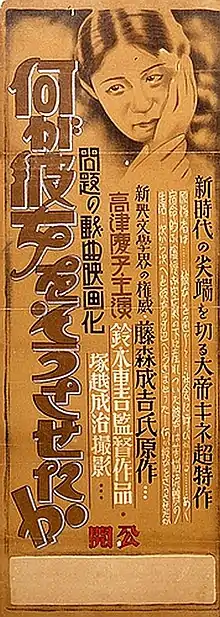What Made Her Do It?
What Made Her Do It? (Nani ga kanojo o sō saseta ka (Japanese: 何が彼女をそうさせたか)) is a 1930 Japanese silent film directed by Shigeyoshi Suzuki, based on the Shingeki play. It was the top-grossing Japanese film of the silent era.[1][2] Notable as an example of a so-called "tendency film" with strong anti-capitalist themes, the film inspired a riot in its showing in Tokyo's Asakusa district[1] with media reports of riots in other cities.[2]
| What Made Her Do It? | |
|---|---|
 Theatrical Poster | |
| Japanese | 何が彼女をそうさせたか |
| Directed by | Shigeyoshi Suzuki |
| Produced by | Teikoku Kinema Engei |
| Written by | Shigeyoshi Suzuki |
| Based on | That Girl Sumiko, What Made Her Do It? by Seikichi Fujimori |
| Starring |
|
| Music by | Silent |
| Cinematography | Seiji Tsukakoshi |
Production company | Teikoku Kinema Engei |
| Distributed by | Kinokuniya |
Release date | 1930 |
Running time | 147 minutes |
| Country | Japan |
| Language | Japanese |
Plot
The plot centers on a schoolgirl, Sumiko (Keiko Takatsu) who has been sent to live with her uncle. Arriving to a harried household with many children, her aunt and alcoholic uncle are annoyed by her arrival. A note, which Sumiko cannot read, announces that her father has killed himself. After being denied schooling and placed into labor for the family, Sumiko is eventually sold to a circus where she suffers at the hands of its members and ringmaster. Sumiko escapes with another circus performer, Shintaro (Ryuujin Unno), but Sumiko joins a team of thieves and ends up arrested. She is given work in the home of a wealthy aristocratic family, who denies even the simplest of pleasures to their staff out of cruelty. She is sent to a Christian orphanage, where she is humiliated for writing a letter to an old friend, and must make a public speech renouncing her ways and accepting Christ into her heart. Given the opportunity, Sumiko instead denounces the church, and ends up burning it down.
Cast
- Keiko Takatsu as Nakamura Sumiko
- Rintarō Fujima as Hiroshi Hasegawa
- Ryuujin Unno as Shintaro
- Yōyō Kojima
- Hidekatsu Maki
- Itaru Hamada
- Takashi Asano
- Saburō Oono
Restoration
The film, thought to be lost after World War II, was restored in 1997 from a partial print found in the Russian Gosfilmosfond archive in 1994. The restoration added title cards approximating what was known of missing scenes, based on a copy of the director's screenplay provided by his family.[3] These notes were added to the start and finish of the film under supervision of Ota Yoneo.[4]
Reception
While contemporary criticism of the film includes film historian Donald Richie's perspective that the film is "a melodramatic potboiler,"[2] the film was a box-office success that lead to increased scrutiny and eventually government censorship of political messaging in films of the era.[2] The film has been compared to radical German theater and Soviet-era propaganda films,[4] though made by a commercial studio which embraced a tendency toward melodrama and vulgarity.[5]
References
- Anderson, Joseph L.; Richie, Donald (1982). The Japanese Film: Art and Industry (Expanded ed.). Princeton (N.J.): Princeton university press. p. 68. ISBN 0691007926. Retrieved 12 December 2017.
- Richie, Donald (2005). A hundred years of Japanese film : a concise history, with selective guide to videos and DVDs/ Donald Richie. Foreword by Paul Schrader (revised edition, 2005 ed.). Tokyo [u.a.]: Kodansha International. p. 91. ISBN 4770029950. Retrieved 12 December 2017.
- Yono, Ota (2000). "Restoration of the movie" (PDF). Bulletin of Osaka Art University (in Japanese). Retrieved 11 December 2017.
- Bernardi, Joanne (2001). Writing in light : the silent scenario and the japanese pure film movement. Detroit [Mich.]: Wayne state university press. p. 318. ISBN 0814329616. Retrieved 12 December 2017.
- Nowell-Smith, edited by Geoffrey (1997). The Oxford history of world cinema (Paperback ed.). Oxford: Oxford University Press. p. 316. ISBN 0198742428.CS1 maint: extra text: authors list (link)